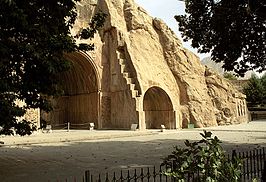Kirmanshah
|
Kermanshah کرمانشاه |
|||||
|---|---|---|---|---|---|
| city | |||||
|
|||||
|
|||||
| Nickname(s): The Land of History & Myths; The Land of Eternal Lovers; The Land of Shirin & Farhad | |||||
| Coordinates: 34°18′51″N 47°03′54″E / 34.31417°N 47.06500°ECoordinates: 34°18′51″N 47°03′54″E / 34.31417°N 47.06500°E | |||||
| Country |
|
||||
| Province | Kermanshah | ||||
| County | Kermanshah | ||||
| Bakhsh | Central | ||||
| Established date | 4th century | ||||
| Government | |||||
| • Mayor | Peyman Ghorbani | ||||
| Elevation | 1,350 m (4,430 ft) | ||||
| Population (2011 census) | |||||
| • Total | 851,405 | ||||
| • Demonym | Kermanshahi | ||||
| Time zone | IRST (UTC+3:30) | ||||
| • Summer (DST) | IRDT (UTC+4:30) | ||||
| Postal code | 67146 | ||||
| Area code(s) | 083 | ||||
| Website | www.kermanshahcity.ir | ||||
| Bisotun | |
|---|---|
| Name as inscribed on the World Heritage List | |
 |
|
| Location | Iran (Islamic Republic of) |
| Type | Cultural |
| Criteria | ii, iii |
| Reference | 1222 |
| UNESCO region | Asia-Pacific |
| Inscription history | |
| Inscription | 2006 (30th Session) |
Kermanshah (Persian: کرمانشاه, Kermānshāh, also known as Bakhtaran, Bākhtarān, Kermānshāhān), the capital of Kermanshah Province, is located 525 kilometres (326 miles) from Tehran in the western part of Iran. According to the 2011 census, its population is 851,405. People mostly speak Southern Kurdish. Kermanshah has a moderate and mountainous climate. Kermanshah is the largest Kurdish-speaking city in Iran.
Because of its antiquity, attractive landscapes, rich culture and Neolithic villages, Kermanshah is considered one of the cradles of prehistoric cultures. According to archaeological surveys and excavation, the Kermanshah area has been occupied by prehistoric people since the Lower Paleolithic period, and continued to later Paleolithic periods till late period. The Lower Paleolithic evidence consists of some handaxes found in the Gakia area to the east of the city. The Middle Paleolithic remains have been found in the northern vicinity of the city in Tang-e Kenesht and near Taqwasan. Neanderthal Man existed in the Kermanshah region during this period. The known Paleolithic caves in this area are Warwasi, Qobeh,Malaverd and Do-Ashkaft Cave. The region was also one of the first places in which human settlements including Asiab, Qazanchi, Tappeh Sarab, Chia Jani, and Ganj-Darreh were established between 8,000-10,000 years ago. This is about the same time that the first potteries pertaining to Iran were made in Ganj-Darreh, near present-day Harsin. In May 2009, based on a research conducted by the University of Hamedan and UCL, the head of Archeology Research Center of Iran's Cultural Heritage and Tourism Organization announced that the one of the oldest prehistorian village in the Middle East dating back to 9800 B.P., was discovered in Sahneh, located west of Kermanshah. Remains of later village occupations and early Bronze Age are found in a number of mound sites in the city itself.
...
Wikipedia





